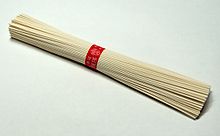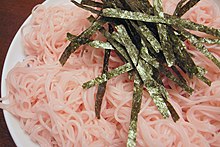Somen
Sōmen ( Japanese 素 麺 , also 索 麺 , Korean 소면 Somyeon ) are very fine, long, round white vermicelli made from wheat flour with a short cooking time. In contrast to most other types of Japanese noodle , the dough is not rolled out and cut into strips, but rather stretched out.
Manufacturing
The dough consists of wheat flour, salt and water, the exact recipe is adapted during production depending on the weather. It is kneaded, rolled out into a large disc and cut in a spiral shape into a long, flat ribbon. To prevent the dough from drying out, it is coated several times with vegetable oil, usually cottonseed oil , during the following steps . The pasta dough is now gradually stretched longer and left to stand in between to mature and rest. Now the noodles are hung on bars and pulled out even thinner. After reaching the desired thickness, the sōmen are dried, cut to the appropriate length and sold in bundles.
history
The noodles are said to have been brought from China to Japan first in the Nara period (710–794) and later during the Kamakura period (1185–1333). It was not until the Edo period (1603–1868), when wheat production increased, that they were eaten more.
preparation
Like Hiyamugi , somen are a summer food. They are usually eaten cold and often served floating in ice water. In addition, a sauce based on soy sauce is served to dunk the noodles.

Occasionally, somen are also eaten in winter, then hot as a soup with vegetables, fish and other ingredients. They are then called Nyūmen.
variants
- Cha Sōmen, with matcha powder
- Tamago Somen, with egg yolk in the batter
- Ume somen, colored pink with Shiso
See also
Web links
Individual evidence
- ↑ a b c d e f Alan Eaton Davidson : The Oxford Companion to Food . Ed .: Tom Jaine. 3. Edition. Oxford University Press , New York 2014, ISBN 978-0-19-104072-6 , keyword “somen” .


